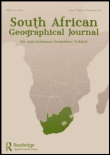
South African Geographical Journal
Scope & Guideline
Advancing geographical insights for a sustainable future.
Introduction
Aims and Scopes
- Climate Change and Adaptation Strategies:
Research focusing on climate change impacts, adaptation strategies, and resilience, particularly in the context of vulnerable communities and ecosystems in South Africa. - Spatial Analysis and Geographic Information Systems (GIS):
Utilization of spatial data and GIS methodologies to analyze various geographical phenomena, including urban development, environmental changes, and resource management. - Sustainable Development and Environmental Management:
Exploration of sustainable practices in urban planning, natural resource management, and community engagement to enhance resilience and environmental quality. - Socioeconomic Dynamics and Urban Studies:
Examination of urbanization processes, inequalities, and the socio-economic factors influencing communities within South African cities and towns. - Natural Resource Management and Conservation:
Investigating the management of natural resources, including water, land, and biodiversity, with an emphasis on conservation strategies and ecological sustainability. - Cultural Geography and Community Perspectives:
Analysis of cultural landscapes, local narratives, and community engagement in geographical and environmental issues, reflecting diverse perspectives in South Africa.
Trending and Emerging
- Climate Resilience and Disaster Risk Reduction:
An increasing focus on climate resilience, particularly in the context of disaster risk reduction strategies, showcasing the need for adaptive measures in response to climate change impacts. - Urbanization and Informal Settlements:
A surge in research examining the dynamics of urbanization, particularly the challenges and opportunities associated with informal settlements in South African cities. - Health and Wellbeing in Urban Contexts:
Emerging studies that explore the intersection of health, wellbeing, and urban environments, particularly in relation to the COVID-19 pandemic and its socio-economic impacts. - Remote Sensing and Technological Applications:
Growing interest in utilizing remote sensing technologies and spatial analysis tools to address environmental issues, land use changes, and resource management. - Social Justice and Environmental Equity:
An increased emphasis on social justice issues related to environmental management and resource allocation, reflecting a broader discourse on equity and community engagement.
Declining or Waning
- Traditional Land Use Studies:
Research focusing solely on traditional land use practices has diminished, possibly due to increasing interest in integrated approaches that consider socio-economic and environmental factors. - Historical Geographical Analysis:
There appears to be a decline in papers centered on historical geography, as contemporary studies increasingly prioritize current issues such as climate change and urbanization. - Rural Geography:
Although rural studies remain important, there is a noticeable decrease in publications specifically addressing rural geography, with more emphasis shifting towards urban-centric research. - Geopolitics and Globalization:
The focus on geopolitics and globalization has waned, as researchers seem to be concentrating more on local and regional issues rather than broader geopolitical analyses. - Conventional Environmental Impact Assessments (EIA):
Research specifically focused on conventional EIAs is becoming less prominent, likely due to the evolving methodologies and frameworks that integrate community perspectives and participatory approaches.
Similar Journals

SaberEs
Unlocking the potential of open-access scholarship in statistics.SaberEs is an esteemed open-access journal dedicated to advancing knowledge in the fields of economics and statistics. Published by the Universidad Nacional de Rosario, Facultad de Ciencias Económicas y Estadística, this journal offers a platform for researchers, professionals, and students to disseminate their findings and engage in scholarly discourse. Since its inception in 2009, SaberEs has made significant contributions to the academic community by promoting rigorous research and critical analysis. With its commitment to accessibility, the journal ensures that its articles are freely available to a global audience, emphasizing the importance of shared knowledge in fostering progress within economic and statistical sciences. Researchers looking to explore innovative methodologies and application-focused studies will find SaberEs to be an invaluable resource in their academic endeavors.
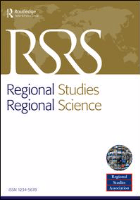
Regional Studies Regional Science
Pioneering Research for a Better Understanding of RegionsRegional Studies Regional Science is a pioneering journal published by Routledge Journals, Taylor & Francis Ltd, specializing in the interdisciplinary examination of regional dynamics and their effects on economic, social, and environmental landscapes. Established as an open-access journal since 2014, it ensures widespread dissemination of knowledge, promoting accessibility for researchers, professionals, and students alike. Based in the United Kingdom, this journal has garnered a notable reputation, holding a Category Quartile ranking of Q2 in 2023 across various fields, including Economics and Econometrics, Geography, Planning and Development, and Sociology and Political Science. Its rankings in the Scopus database reflect its growing influence within the social sciences, positioning it as a valuable resource for contemporary regional studies. With a commitment to high-quality research, Regional Studies Regional Science serves as a vital platform for the exchange of innovative ideas and empirical findings that address the pressing challenges faced by regions worldwide.
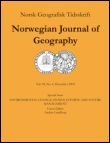
Norsk Geografisk Tidsskrift-Norwegian Journal of Geography
Unveiling the dynamics of our changing world.Norsk Geografisk Tidsskrift-Norwegian Journal of Geography, published by Routledge Journals, Taylor & Francis Ltd, is a pivotal peer-reviewed journal that has been instrumental in advancing the field of geography since its inception in 1926. With an esteemed Q2 ranking in both Earth and Planetary Sciences and Geography, Planning and Development categories, it serves as a vital resource for researchers, professionals, and students seeking to deepen their understanding of geographical phenomena. The journal's rich historical archive, covering significant periods in geography and environmental studies, showcases a diverse array of articles that reflect ongoing research trends and challenges within the field. Despite not offering Open Access, its impactful content remains accessible through institutional subscriptions, underscoring the journal's commitment to advancing geographical research and fostering scholarly dialogue. As it continues to publish high-quality research, Norsk Geografisk Tidsskrift stands as a key player in geographical scholarship, reinforcing its importance within the academic community.
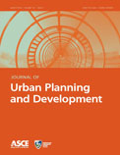
JOURNAL OF URBAN PLANNING AND DEVELOPMENT
Navigating the Challenges of Modern Urbanization.The JOURNAL OF URBAN PLANNING AND DEVELOPMENT, published by the ASCE-AMER SOC CIVIL ENGINEERS, stands as a pivotal platform in the realms of urban studies, civil and structural engineering, and development. With an ISSN of 0733-9488 and E-ISSN of 1943-5444, this journal aims to disseminate high-quality research addressing critical urban planning challenges, fostering innovative solutions, and contributing to sustainable development practices. Spanning from its inception in 1979 to the anticipated issues up to 2024, the journal proudly occupies the Q2 category across multiple disciplines, including Civil and Structural Engineering, Development, Geography, Planning and Development, and Urban Studies. Its noteworthy Scopus rankings reflect its influence, notably being positioned in the 76th percentile in Urban Studies. With no open access options currently available, the journal remains a selective forum for scholarly discourse, attracting researchers, professionals, and students eager to engage with cutting-edge developments in urban planning and design.

Geo UERJ
Advancing Research for a Sustainable FutureGeo UERJ is a renowned open-access journal published by Universidade do Estado do Rio de Janeiro (UNIV ESTADO RIO JANEIRO), focused on the multifaceted study of geography and related disciplines. Established to foster innovation and disseminate high-quality research, Geo UERJ has been dedicated to making scholarly work accessible since its transition to open access in 2007. The journal aims to provide a platform for researchers, professionals, and students to share insights into geographical phenomena, environmental issues, and urban studies, contributing to the global discourse on sustainability and spatial analysis. Its publications serve as valuable resources for academicians looking to stay abreast of cutting-edge developments within the geography field. With the ISSN 1415-7543 and E-ISSN 1981-9021, Geo UERJ invites contributions from diverse perspectives, enriching the academic landscape with important geographic research from Brazil and beyond.

Annals of the American Association of Geographers
Exploring the Frontiers of Geography and Environmental ScienceAnnals of the American Association of Geographers is a leading academic journal published by Routledge Journals, Taylor & Francis Ltd, and is based in the United Kingdom. With an impact factor positioning it in the Q1 category for both Earth-Surface Processes and Geography, Planning and Development, it stands as a pivotal resource for researchers and professionals in the fields of geography and environmental sciences. The journal’s broad scope accommodates a diverse range of topics, including spatial analysis, environmental change, and human geography, reflecting the dynamic nature of geographical research. Accessible in both print and digital formats, the journal encourages open dialogue and dissemination of knowledge among its authors, readers, and the academic community. As it converges through the years from 2016 to 2024, the Annals continues to showcase high-quality research that influences geographic thought and practice, making it essential reading for students, academics, and practitioners alike.
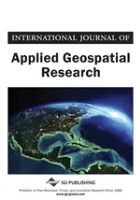
International Journal of Applied Geospatial Research
Navigating the future of geography and Earth sciences.International Journal of Applied Geospatial Research is an esteemed publication dedicated to advancing the field of geospatial research. Published by IGI Global, this journal provides a platform for innovative studies from 2010 to 2024 that encourage multidisciplinary contributions across Earth and planetary sciences and geography. While currently not offering open access, the journal's focus on applied research ensures that it remains highly relevant to both academics and industry professionals alike. With an ISSN of 1947-9654 and an E-ISSN of 1947-9662, it has been indexed in various databases, reflecting its emerging significance with rankings such as Q4 in Earth and Planetary Sciences and Geography according to Scopus, placing it at the intersection of critical research and practical application. Researchers, professionals, and students can expect insightful articles that enhance understanding and drive innovation in geospatial applications essential for informed decision-making in a rapidly changing world.

Geografia-Malaysian Journal of Society & Space
Pioneering Insights into Regional Studies and Spatial PracticesGeografia-Malaysian Journal of Society & Space, published by the esteemed Universiti Kebangsaan Malaysia through its Faculty of Social Sciences & Humanities, stands as a vital platform for scholarly discourse in the fields of geography, social sciences, and spatial studies. With its ISSN 2180-2491 and E-ISSN 2682-7727, this journal emphasizes the importance of regional studies, fostering a deep understanding of societal dynamics within the Malaysian context and beyond. Although currently lacking impact factor and HIndex data, the journal is poised to contribute significantly to academic discussions, urging researchers, professionals, and students to explore spatial complexities influencing social structures. Geografia aims to publish high-quality, peer-reviewed works, focusing on innovative theoretical and empirical research that addresses contemporary issues in society and space. By promoting open access to its content, it ensures that knowledge is freely available, furthering academic engagement and collaboration in the global scholarly community.

Southeastern Geographer
Advancing Insights in Earth and Planetary SciencesThe Southeastern Geographer is a prominent academic journal published by the Association of American Geographers, dedicated to advancing knowledge in the fields of Earth and Planetary Sciences and Geography, Planning and Development. With an ISSN of 0038-366X and an E-ISSN of 1549-6929, this journal has been a staple in geographical scholarship since its inception, offering a platform for diverse research that spans over four decades, specifically from 1979 to 1994 and then from 1996 to 2024. The journal is currently classified in the Q3 category within its fields, indicating its significant influence in shaping contemporary geographical discourse. Researchers, professionals, and students alike benefit from its rigorously peer-reviewed articles that explore regional studies, environmental issues, and sociocultural dynamics, making it essential for anyone interested in the interconnectedness of geography and society. As a vital resource for advancing geographical education and research, the Southeastern Geographer continues to engage its audience with innovative insights and scholarly contributions.

Geoadria
Bridging Disciplines for a Sustainable FutureGeoadria, an esteemed Open Access journal published by the University of Zadar in Croatia, has been at the forefront of disseminating valuable research since its inception in 1996. With a keen focus on atmospheric science, demography, earth-surface processes, and geography, this journal serves as a crucial platform for researchers and professionals aiming to explore the intricate relationships between these fields. Although it currently holds a Q4 quartile ranking in various categories, such as Atmospheric Science and Geography, its commitment to promoting innovative scholarly dialogue ensures its relevance and utility within the academic community. Geoadria is indexed in Scopus, with rankings that reflect its ongoing contribution to the social sciences and earth sciences, notably garnering attention in niche areas. With a dedication to open access since 1996, the journal stands as a testament to the University of Zadar's commitment to enhancing global knowledge. Researchers, professionals, and students interested in geography, demography, and environmental sciences will find Geoadria a vital resource for the latest empirical studies and theoretical discussions.